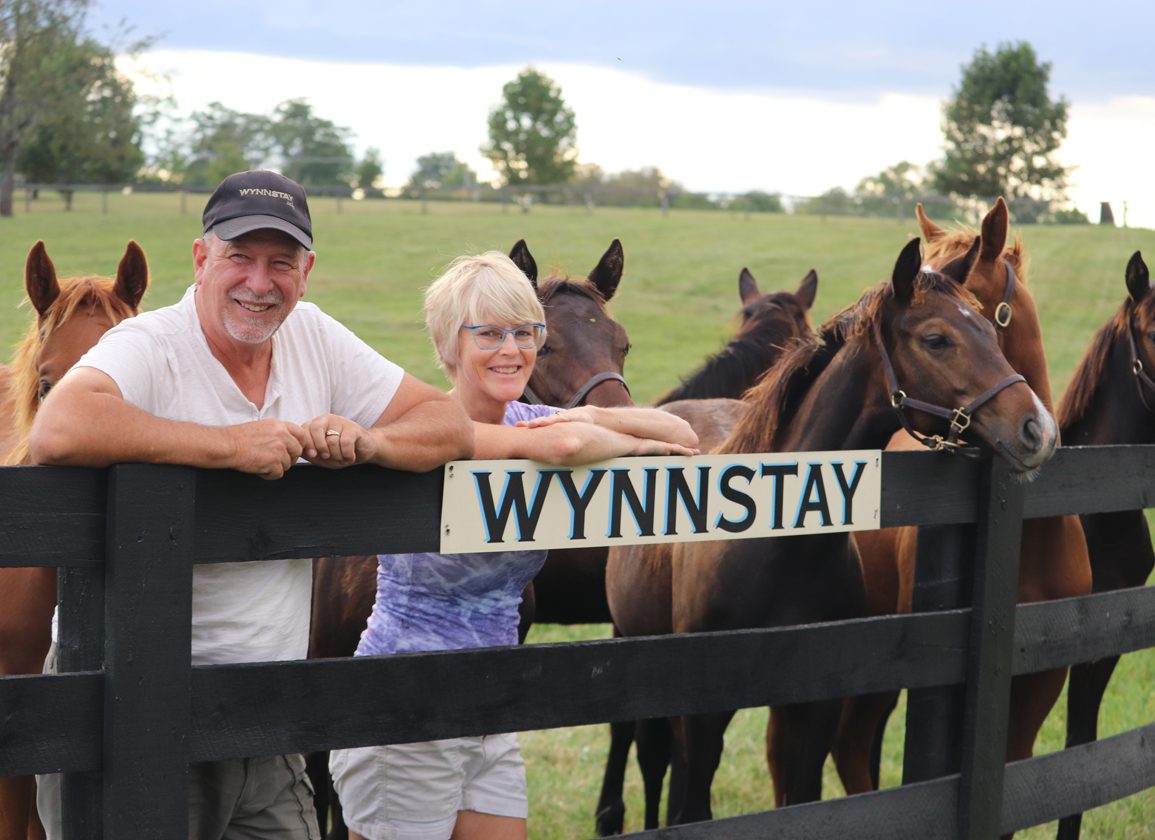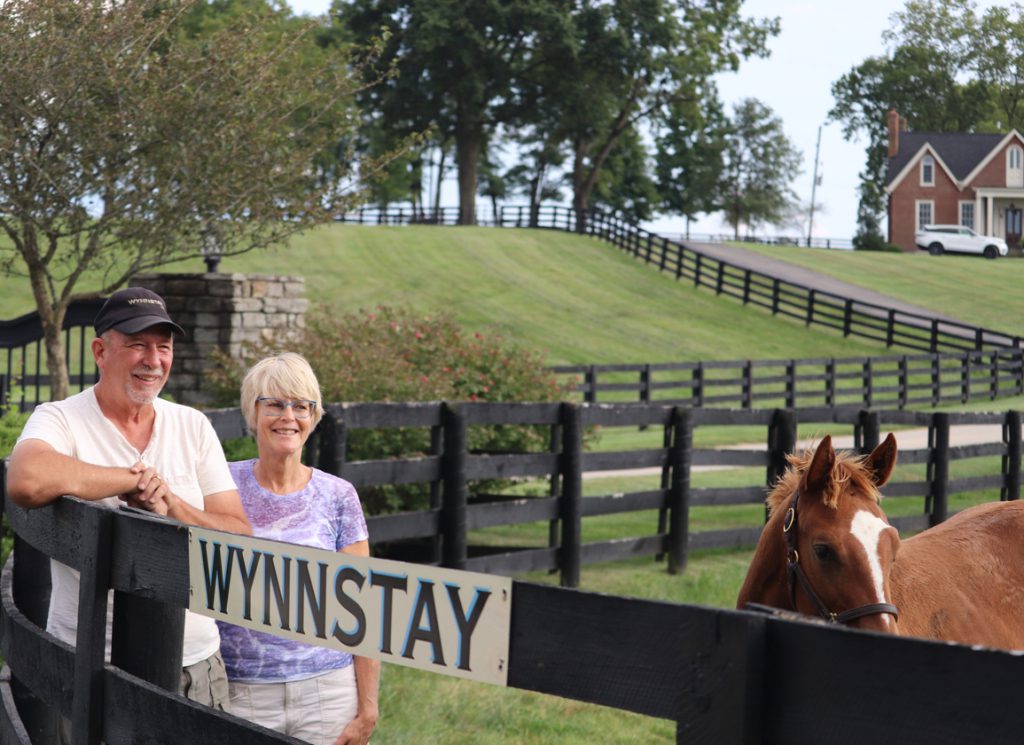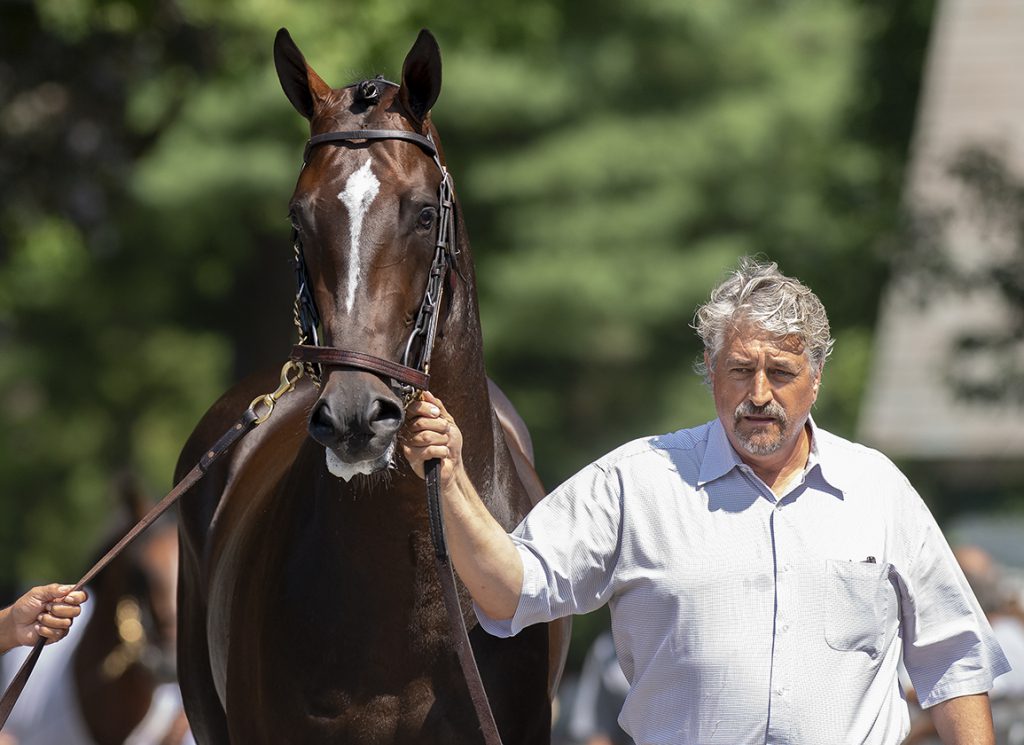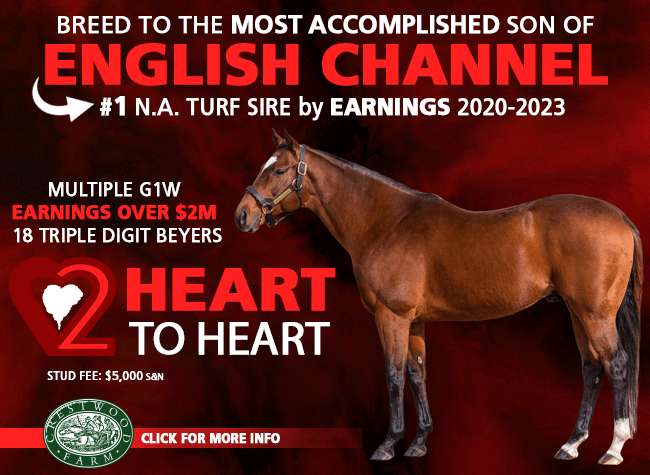By Chris McGrath
“Her dad should have shot me,” says Tim Hamlin wryly.
Needless to say, he had met Nancy at a horseshow. She had just started out on her veterinary studies. “And she quit school to come to a little town in northwest Iowa to help me,” Hamlin recalls. “This was '84, we were kids, had no money. We lived in a single wide trailer house for seven years. Nancy would get up at 4 a.m. to make donuts, so we could buy horsefeed.”
Eventually they found a filly that emboldened a roll of the dice.
“First horse I ever borrowed money on,” Hamlin says. “Had her in a sale in Oklahoma. And two or three days before, I walked out the barn and there she was lying dead. No insurance. So then we had to pay the bank back on a dead horse.”
He shakes his head. “You've got to be stubborn in this game,” he says. “For every good thing that happens, there'll be two bad. Why we put ourselves through it, I don't really know.”
Except he does, perfectly well. Hamlin finds the picture on his phone.
“This says it all to me,” he says. “That's our daughter after the race.”
He smiles at the tears of joy streaking the face of this accomplished young woman, who had seen enough of her parents' lifestyle to go to law school instead. “You know, we were just a couple of horse nuts,” he reflects. “That's all we cared about. But somehow you just go on, day to day to day, and now here we are.”

Allen Poindexter and Outwork
“Here” is the porch of a beautifully restored antebellum farmhouse near Winchester, Ky.; and the race that so moved their daughter was the GI Spinaway S. at Saratoga last month. For the Hamlins, in partnership with Allen Poindexter, bred the winner Brightwork (Outwork) from a Malibu Moon mare unearthed for just $17,000 at the 2016 Keeneland November Sale. Now unbeaten in four starts, Brightwork heads to the GI Alcibiades S. on Friday as the leading filly of her crop.
But her emergence actually seals a second cycle of vindication for those early years of sacrifice. For prior to arriving in Kentucky, 17 years ago, the Hamlins had already reached the pinnacle of the Quarter Horse world. In fact, it was partly the sale of an All American Congress grand champion—bought as a baby for just $20,000—that enabled a new start in Thoroughbreds. The reasons for switching breeds, however, carry a warning for the community they joined.
“Okay, so we quit when we were on top,” he acknowledges. “But we didn't see a lot of future with what was going on there. The Quarter Horses had a genetic defect. There'd been too much inbreeding. And there was one particular stallion, Impressive, that mutated a gene. He was so beautiful, everybody had to have his sons and daughters. Well, 20 years down the road, when they were producing foals, whenever you bred Impressive to Impressive, 50 percent of them would have this hot gene. And they were like fainting goats: they'd just drop over and some would die.”
The guidance on hyperkalemic periodic paralysis was that you could evade the mutant gene by testing, and only breeding negative to negative.
“Well, it just so happened that the best show horses, with the big muscle, with the good hair, all tended to be positive,” Hamlin explains. “We'd enjoyed it. And we were good at it. But we had 100 of them, and felt like we were on a train running away down the track, and had to get off. So we did. We sold everything and moved out here.”
Hamlin, who traces this disaster to artificial insemination, perceives a perilous equivalence in the explosion of Thoroughbred book sizes.
“When I was a kid, there were 15 stallions within an hour radius of my house,” Hamlin remembers. “And they all had 10 to 20 mares. By the time we left, we had the only stallion left in the whole of northwest Iowa. Shipped semen ruined the [Quarter Horse] stallion business, and then the gene pool as well. Boom, 20 years, all the old blood was gone. And once it's gone, it's gone. And what's left is all related.”
Nobody, he cautions, can know what genetic devils might now be being entertained unawares.
“No question, people in the Thoroughbred world need to know about this,” he says. “When I tell people, they think I'm crazy. But we watched it happen firsthand. You can't go to a horse show nowadays and find one without Impressive in the pedigree. He was the most beautiful horse I ever saw in my life. But you now have to test for seven different genetic defects when you register your Quarter Horse foal. Seven!”
How, for instance, does anyone know whether Thoroughbred breakdowns might reflect some genetic vulnerability?
“We haven't even begun to look in that area for defects,” Hamlin says. “With Quarter Horses, they had to figure out what was going on, fast, because they were just dropping dead. We just don't know what could be coming, with all the Northern Dancer we have, all the Mr. Prospector. Why do horses bleed? We don't know. Because we're not doing the testing.”
In some ways, Hamlin is nostalgic for the days before ovulatory agents and ultrasound.
“Whenever I have this conversation, people say, 'This is the United States of America and we can breed as many mares as we want,'” he says. “Well, that's true. But when books were 50 or 60 mares, a lot of those mares had to be bred several times. Now it's a one-shot deal. You make them ovulate, bring on the next one. If The Jockey Club wanted to do something, maybe they should look into letting Nature take its course.”
Be all that as it may, the upshot was that the Hamlins once again found themselves in a trailer house. This time, it was because the Bluegrass farm that had captured their imagination was in a daunting state of repair: 70 rough acres that had long supported only a few ponies, some cattle, and crops.
The house was built by a Captain Bush, when granted 3,000 acres of Clark County as reward for service in the war of 1812. He brought his bride, Martha Wynn, and they called their home Wynnstay. The Hamlins revived the name, rightly feeling that it combines two aspirations: to win, and to last the course.
The Hamlins had been introduced to Thoroughbreds by the late Lazaro Mata, a Cuban horseman described by Hamlin as one of the best he has ever been around. They collaborated in some pinhooking experiments in Ocala, albeit the first turned into the type from which you learn fastest.
“There was a colt by Icecapade we really loved,” Hamlin recalls. “But he cost $100,000, which was all we had to spend. So we bought three $30,000 babies instead. One broke her leg, one had a bad throat, the other just couldn't run. And then we watched the Icecapade bring $600,000.”
Nonetheless Mata encouraged their Kentucky reset—and so, too, did another friend. “Man, you guys would be good at this,” Chris Baccari told them. “You already do the breeding, the showing, you get them ready for the sales. You can do this.”
They landed running, all but doubling their money on a $155,000 weanling colt by Tapit–at $300,000, much the most expensive yearling in the future champion's debut crop–between November and September Sales. Immediate encouragement, then, that their skills would prove transferable.
“You have to work Quarter Horses hard enough to make them look good,” Hamlin reflects. “So being sound is a big part of it. But they spend a lot more time inside. We've learned that Thoroughbreds do best outside. Ours go out every day up until the sale.”
As for physique, Hamlin still prizes similar attributes to those he once sought in a roping horse, a cutting horse, a barrel racer. And while he feels that standards may have slipped in his previous world, where structural defects are increasingly indulged for bulk and muscle, his own purist standards have stuck.
“We pick out the same things now that we did with the show horses,” he says. “A lot of Book I horses at Keeneland look just like the horses we used to have: hair's perfect, weight's perfect, they're athletic, sound-looking.”
One way or another, the Wynnstay formula is paying off. For Brightwork, as we'll see, is not an untypical project. Her dam Clarendon Fancy was acquired as a young, unraced mare by Malibu Moon, in foal to Colonel John—a sire already on the page through GIII Iroquois S. winner Cocked And Loaded, the first foal of Clarendon Fancy's full sister Catch The Moon. The Hamlins especially liked the damsire, Yes It's True. He had always reminded them of a show horse: big, athletic, plenty of hip.
“We don't give a lot of money for our mares,” Hamlin says. “We can't. Whatever we make, that's what we can spend. Clarendon Fancy was back in Book 4 or 5. But she was beautiful. We sent her out to Iowa, to foal her out, because Allen has been the leading owner out there for 11 or 12 years.”
Unfortunately that first foal was lost. But meanwhile things started happening to the pedigree: Catch The Moon produced GI Haskell winner Girvin (Tale Of Ekati) and later GI Preakness runner-up Midnight Bourbon (Tiznow).
With the emergence of Girvin, someone offered $250,000 for Clarendon Fancy in foal to Nyquist. But she turned out not to be pregnant, and the deal was off.
Eventually this disappointment would prove just another example of how hard it is, in this business, to tell your good luck from your bad, and vice versa. In the meantime, however, a return to Nyquist brought only fresh frustration. One summer night, freaked out by a bull, Clarendon Fancy took off round the field–and kept going. Next morning they found a fetus.
The only crumb of comfort was that her first foal, by Temple City, had now gained some minor black type. Nonetheless, Hamlin's friend Mark Toothaker, at Spendthrift, was reluctant to admit Clarendon Fancy into the first book of Bolt d'Oro.
“I can't,” he said. “I'd lose my job!”
“It will be the best foal you get,” promised Hamlin.
After much arm-twisting, Toothaker relented.
“Well, she had Bolt's highest-selling filly that year: $280,000,” says Hamlin with a chuckle. “And it was Spendthrift that bought her!”
And that filly is now a valuable breeding prospect, thanks to Clarendon Fancy's next cover. The choice of Outwork was inspired by a colt raised by Wynnstay for a client, and sold for $140,000 as a weanling at the 2018 November Sale. As Outadore, he made the podium in the GI Breeders' Cup Juvenile Turf.
“We loved that colt,” Hamlin explains. “He was a beautiful mover, correct, great-minded. So we took a shot on Outwork. We didn't want to spend a lot: the mare was kind of a disappointment, but we didn't want to get rid of her. We do fall in love with these mares. We don't just buy and sell, buy and sell. We try to make them work.”
So the only two Outworks raised at Wynnstay have been Outadore and now Brightwork.
“As a baby, she was perfect,” Hamlin says. “I wouldn't change a thing. So when Fasig-Tipton came out to look at babies for their 'Night of The Stars', they're like, 'An Outwork? I don't know.' And I said, 'Yeah, but she's too good to miss. Somebody's going to find her.' And Jared Hughes did.”
Though Clarendon Fancy was left open after delivering a Yaupon filly late this spring, she is still only 11. And with Brightwork extending a new limb on what has become a highly commercial family tree—Clarendon Fancy's daughter by Volatile brought $285,000 from Ocala Stud at Saratoga the day after the GIII Adirondack S.—these are exciting times for Wynnstay and their partner.
Poindexter has been a client more or less since the Hamlins came to Kentucky. “Allen's been great,” Hamlin stresses. “He runs a big business, only comes out here once or twice a year, but he's one of the most competitive people I know. We probably couldn't have done this without him. He has enabled us to experiment.”
As a result, Wynnstay has now expanded to 225 acres; and has many luminous graduates besides the one now shining so brightly. Skelly (Practical Joke), for instance, looked one of the fastest horses in the nation when running up a sequence earlier this year. Sold for $250,000 as a yearling, he was homebred by Poindexter from a Bwana Charlie mare originally acquired in utero with her $8,000 dam, Game For More (More Than Ready).
Game For More herself, meanwhile, produced Grade II winner Isotherm (Lonhro {Aus}) and Grade I-placed Gio Game (Gio Ponti) before delivering one of the last three colts by Giant's Causeway. He was sold for $500,000 and, as Giant Game, was placed in the GI Breeders' Cup Juvenile and has this year become a graded stakes winner.
“So in one day we sold Giant Game and Skelly for $750,000,” marvels Hamlin. “And both from that $8,000 mare. We were at the yearling sale with Allen and there was a Heiligbrodt dispersal afterwards, and there was nobody in there.
He bought three: two for $8,000, one for $16,000. All three have had graded horses; and all sold six-figure babies.”
Now, moreover, one of Game For More's daughters has produced The Wine Steward (Vino Rosso) to win his first three starts including the Bashford Manor S. He was another to have spent formative months on the farm.
Once again, then, old Quarter Horse lessons have rung true.
“Game for More was a beautiful mare, only she'd had a bad stifle and her hip was kind of atrophied away,” Hamlin recalls. “But you could see her bone structure was good. That's what we used to have to do with the Quarter Horses: buy cheap mares and breed to good stallions to get show horses. It's no different now. We have 10 graded stakes-producing mares here that cost nothing.”
That's out of no more than 30, many still too young to have had their produce tested on the track. Quite plainly, then, there's a special affinity at work here.
“These babies, you can't let them get sick,” Hamlin says. “You have to look around the corners. You can't treat them for rhodococcus, for instance: it scars up their lungs, they don't run. So you have to see it before they get it.”
It was for much the same reason, a few years ago, that the Hamlins started consigning their own horses: with horses, they feel, it's always about engagement; about getting on the right wavelength.
“We used to go to Saturday night auctions and buy crazy horses that nobody else wanted, take them home and fix them,” Hamlin recalls. “Some you could, some you couldn't. But their brain is a big part of it. A lot of it is they're just scared. You have to earn their trust.
“I hate it when I submit a mare and they tell me that she's this or that: it's not a good enough nick, she's too old.
Because we put a lot of thought into which mare to breed to which horse. The stud farms don't know what your mare needs. They don't see them.”
And don't start him on nicks.
“We don't want computers raising our horses,” he scoffs. “One time we bought the prettiest Quarter Horse mare that I have ever seen, and I bred her to our stallion. And her baby looked like a mule. And I was sick, because it wasn't supposed to look like that. So I bred her back to the same stallion and everybody was like, 'What are you doing? You crazy? You're going to get another donkey.' And that mare had the prettiest gray colt God ever stuck on the earth, and we sold him for tons of money. But I don't know if too many people that would've done it again.”
So here's a couple that arrived with no inherited assumptions. And, in such testing times, perhaps we can learn from their willingness to challenge orthodoxy.
“We can send men to the moon, but we can't have a horse live a normal life with a prosthetic leg?” Hamlin asks. “We can't just kill them on the track. It's not going to last, people won't stand for that. I think we need some outside help, we need scientists to help us figure it out.
“The money's the easy part. All you have to do is, at the gate, say: 'Please give us a dollar: we're going to make a weightless chamber for these horses to live in, while they're healing.' People wouldn't give you a dollar. They'd give you $100.”
Just another example of marching to a different beat—but one worth heeding, surely, given how this farm is striking gold in neglected seams of the market.
Mind you, if they can do this kind of thing with mares bought for as little as $8,000, what they might do with one that cost $800,000?
“Oh, I always think about that,” Hamlin says. “But nobody gives us that kind of chance.” He shrugs and smiles. “We don't need that. We just do our own thing.”
Not a subscriber? Click here to sign up for the daily PDF or alerts.










